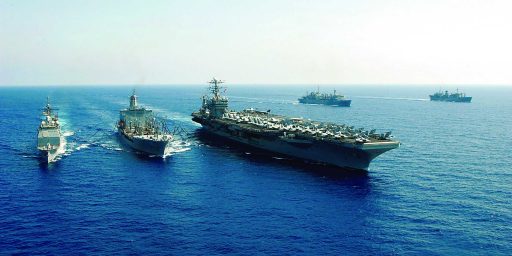Virtual Financial Crisis
In the online game Eve Online we might see a virtual version of what is happening in today’s credit markets.
The player-driven economy of EVE Online is a major draw for gamers interested in virtual finance, although for very different reasons; some players enjoy managing vast funds in the game, others are primarily in it for a shot at a major heist. Sometimes, even those who start out with the best intentions succumb to temptation. Regardless of the motivations one has to build up (or tear down) something in the game, left up to their own devices, some EVE players aren’t simply content with the existing game mechanics when it comes to financial instruments. As such, they’ve established their own banks, IPOs, and other types of investments.
The more reputable banks and funds have built-in safeguards that limit any one employee’s access to the deposited ISK, as — let’s face it — this is EVE and such contingencies are necessary. More than a few players eye that cache of billions of raw ISK, Blueprint Originals, and other assets, and simply want to pull a runner. This has been the case just this week, with the player-run Dynasty Banking, which was apparently taken for billions of ISK by Xabier, the former Dynasty Investments Manager who had access to funds invested by EVE’s playerbase.
Massively contacted Xabier today, who stated that the value of assets taken from Dynasty Banking was 86 billion ISK, adding that the total value is now 106.2 billion ISK due to how it was invested.
Now you might be thinking, “C’mon that is just some dumb computer game.” Yes it is a computer game, but note the opening paragraph, especially the part abou the game being player driven. Many of the items that players can buy on the market come from other players. These players have blue prints for ships and ship modules. They research them to lower production costs. They’ll buy their own small space stations at which to build these items, hire a player run corporation that specializes in mining to provide them with the necessary minerals or buy them off the market from independent miners. Then they’ll place sell orders and keep an eye on the competition, watch prices in different regions of the game and shift production as prices fluctuate. The more serious players will have spreadsheets showing various cost-benefit calculations based on ore and mineral prices and ship and module prices. And unlike many economics experiements these people pay to be part of this huge experiment.
So who buys lots of these ships? Other players who aren’t as interested in production, research or mining. Vast portions of the “game space” is un-controlled or “lawless”. However players and their corporations or alliances can take over those portions of the game space. Thus there are large segments of the game space that are player controlled. And yes, they do go to war against each other.
For example a few weeks ago the alliances Band of Brothers (BoB), Against All Authorities (-A-), Executive Outcomes (EXE), and some others have declared war on Goonswarm and the Tau Ceti Federation in the “south”. These latter two alliances called in allies from the “north”–the northern coalition meaning that alliances Razor, Morsus Mihi and others are also involved. In addition Pandemic Legion as moved into the area to fight. Further some newer alliances see this as an opportunity to become holders of lawless space as well and have joined in the war. So what does all that mean? It means that now lots of ships are getting blown up. But these players simply go buy new ones that other players in empire produce. So this has had an effect on various mineral prices. For example the mineral tritanium has gone from a low of 2.2 ISK (the in game currency Inter-Stellar Kredit) to 3.8 ISK. Now many of the miners in empire space (i.e. high security space where it is harder to kill players) are hoovering up all the veldspar in their mining barges, the ore that produces the most tritanium.
How do I know all this? I…ahem…play the game.
What will be the impact of the bank heist above? Well, I don’t know. First off I do know that the company providing the game, CCP, will almost surely do nothing. It is a very hands off game. Aside from a few rules on where and when you can kill players and bans on various actions deemed exploits the developers tend not to get too involved in the game on a day-to-day basis. Also, there have been bigger financial scandals with little or no response by CCP.
Also, many players simply hold on to their cash. Since the financial laws are literally non-existent many players are hesitant to trust another with their hard earned ISK. Still many players who did put money into a bank that had a good reputation might be thinking of pulling out and demanding their isk back. This could spread like a contagion to the other banks in the game thus destroying that industry. So what are the other banks doing?
EBANK, now the largest player-run bank in New Eden, has stated it’s willing to assist in the event that this run on Dynasty Banking becomes serious. Ricdic, the Managing Director of EBANK, doesn’t believe it will be necessary to provide this assistance, however. He stated earlier today, “From what I have seen after talking to Manalapan it’s quite likely EBANK won’t need to assist at all but it can’t hurt to have that extra backup just in case.” The run on the bank has hit 30 billion ISK thus far, but Manalapan remains confident that Dynasty Banking’s reserves of roughly 100 billion ISK on hand should be adequate to handle this fallout caused by the theft.
One of the things about games like Eve Online is that they are basically huge experiments with hundreds of thousands of players (Eve itself has around 300,000 players). Thus, they could provide some interesting data as to what happens in an economy when things like a financial crisis occurs or even what causes them. Not all of these kinds of events have to be caused by player malfeasance though. Changes to the game mechanics do happen. For example, deflation has been something of an issue in the New Eden (the virtual galaxy this all takes place in) economy. I’ve wondered if this deflation is an artifact of changes in game mechanics. There are two tiers of ships and ship modules: tech 1 and tech2. Tech 2 ships and modules are usually better (although harder to fit on a ship or fly if it is a ship). Initially these items were very, very expensive as only a few players obtained the blue prints to make them via lottery. However, the developers added invention to the game so that an enterprising player could make these coveted items. Naturally with extremely high prices players jumped into the invention aspect of the game and the prices have plummetted. For example, the latest ship to join the game is the Orca, a capital ship used in large scale mining operations. Inital prices I heard for that ship were around 800 million isk. Now the median price is around 500 million. In this case deflation in the overall price indices may not be as bad as it is often thought.
Via Alex Tabarrok.






C’mon that’s just some dumb computer game.
I don’t think the game can truly simulate a real economy for 2 reasons:
1)Where can you find an economy that consists solely of “gamers interested in virtual finance?”
2)What government would be as hands off as CCP in any situation close to this?
This objection applies to all economic experiments since they most are typically virtual.
Provides for an interesting case, IMO. In a game where scamming is actually considered a valid form of game play…the economy is surprisingly robust.
I certainly won’t dismiss it. Not after the “Corrupted Blood” incident on World of Warcraft, where the CDC apparently called them up and asked for statistics with regards to modelling.
Dude, you should try Grand Theft Auto–its much cooler (and realistic).
Every market is a credit market now. We now owe the entire GDP. At an average corporate profit margin of 8.3 to 11.6%, depending on who you talk to, say 10%, we should be able to pay it off in 14 years assuming that we don’t buy food, shelter, or clothing in the meantime.
Steve, I like the idea of using this as some sort of model or experiment. However, I’d be interested to know what the ratio of ISK to real dollars is, simply to be able to accurately measure risk. People are going to be a lot more aggressive in an online world where a mistake may only cost them 5 bucks. Ever play poker online at a free site? It’s impossible to read people who aren’t really risking anything.
The main difference in a game like this than in a poker site, is that there is much less turn-over. With a poker site, as with any traditional games, there’s no lasting interest. Whereas in an RPG, there becomes much more emotional stake at play. And because of that, its real-world parallelism is much more reliable.
A $35 Game Time Code will net you 600 million isk. This is the “official” exchange rate in that buying isk this way wont get you banned. Buying it off of Ebay or other sites will be cheaper, but if you get caught you are banned from the game.
Yes, you’ll have to factor that in. Still $86 billion using the above exchange rate is $5,000 or so. And yes, there are items in the game that cost that much (e.g. Titans a super-capital ship of course these can be insured in game).
I used to play EVE Online. In fact, I was there for the beginning of the game, and played for almost 4 years. However, the corruption, exploits and special favoritism drove me away. There have been many scandals involving the development team, and a select group of players over the years.
EBANK’s Board has approved expansion to 2 Trillion ISK in deposits. As I write this, we’ve hit 1.75 Trillion. To put this in perspective, to “buy” 1.75 Trillion ISK you would need to buy $102,083 worth of GTCs.
We have 4,600+ users and plan to build more infrastructure for a secondary market outside of the game (in-game markets are “primary” markets) including a securities exchange and a way to move money between trusted third-parties, similar to PayPal.
As the utility of EBANK increases, so too will the volume of cash it holds and moves. Another interesting fact, EBANK has processed roughly 6 Trillion ISK since it started a bit over a year ago. Trillions more have been processed in withdraws.
EBANK credits a total of 1 Billion ISK to it’s customers EACH DAY.